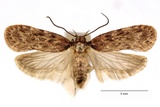Depressaria chaerophylli Zeller, 1839 Species
Last modified: Dec. 8, 2025, 4:44 p.m.
A very rare and local species in Belgium.
Details
- Classification
- Family: Depressariidae > Subfamily: Depressariinae > Genus: Depressaria > Species: Depressaria chaerophylli
- Vernacular names
- Kervelplatlijfje (NL)
- First mention in Belgium
- Fologne E. 1859b. Supplément au catalogue des lépidoptères de Belgique. — Annales de la Société entomologique belge 3: 133–142. On page 136 (as Depressaria chaerophyllinella. Zell.). view page
- Status
-
Native
Distribution
Caterpillar
Yellowish green with a dark grey or dark brown dorsal line; head capsule yellowish with black spots; prothoracic plate green with a black mark laterally and some black spots; last abdominal segment yellowish green; pinacula inconspicuous, black.
Cocoon/pupa
A loose spinning, pupa brown.
Bionomics
The final instars feed on the flowers and the seeds of the foodplant; June–July.
The last instar spins a loose cocoon in the soil or among detritus; July.
The species hibernates in the adult stage. The moths hide in sheltered places and are rarely seen. The adults are active at night and occasionally come to light.
Flight periods
One generation a year: from the end of July and after hibernation from March till early May.
Observed on
- Host plant (species):
- Chaerophyllum temulum
Monophagous on Chaerophyllum temulum.
Habitat
Woodland margins, old hedgerows, old trackways and sunken lanes where the foodplant grows.

